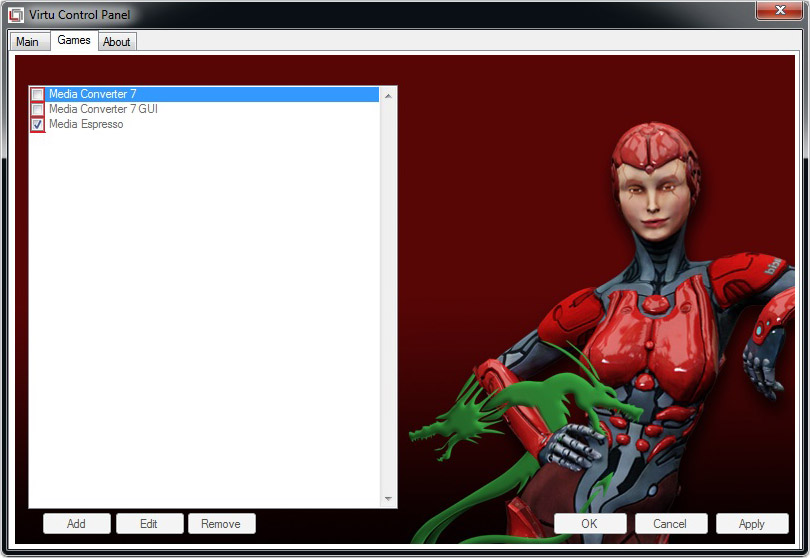Intel Z68 Express Chipset Preview: SSD Caching And Quick Sync
Enthusiasts were forced to hit the brakes on Sandy Bridge when motherboard vendors massively recalled platforms based on Cougar Point. We take a Z68 Express-based board for a spin to see if you should wait for Intel's true LGA 1155 enthusiast chipset.
Lucidlogix Virtu, Revisited
Remember that Lucidlogix’s Virtu software gets around the limitation of only being able to access Intel’s Quick Sync transcoding acceleration technology while using integrated graphics. My biggest gripe with it was that Lucid required you hook up to the HD Graphics display output. The problems there were:
- HD Graphics is limited to a single-link DVI output. So much for my 30” test bed.
- Discrete graphics “virtualization” means compatibility issues to consider, necessitating a white list.
- Performance also takes an inherent hit. Lucidlogix masked this as much as possible, but my benchmarks still revealed situations where you’d see a substantial dip (Can Lucidlogix Right Sandy Bridge’s Wrongs? Virtu, Previewed).
Well, version 1.0.105, posted to Lucidlogix’s Web site as a trial, lifts what I saw as this app’s biggest restriction. Mainly, you’re now able to run natively from discrete graphics and virtualize HD Graphics instead. Instead of seeing a list of validated games in Virtu’s control panel, you’ll get a list of validated media apps. There are far fewer of those, making the compatibility question an easier one to answer. Right now, MediaEspresso and MediaConverter are on the list—and we’re fine with those two options for now.
That’s great news. Ninety five percent of the time you can use a Z68-based platform the same way you would have used a P67-based box, gaming from any of your graphics cards’ display outputs, with no white list or compatibility concerns. When it comes time to transcode a movie for your iPad or iPhone, run it through Quick Sync. As before, it’s not going to be native performance, but it’s really danged close, as you’ll see in the benchmarks.
It's important to note that Lucidlogix is going to offer motherboard vendors different types of Virtu licenses. This is going to be largely transparent to end-users, aside from its effect on price (though that should be minimal, too). In essence, a copy of Virtu licensed for a board that offers SLI or CrossFire support will cost more than Virtu for a single-slot board aimed at the mainstream market. I have to hope that motherboard vendors licensing this technology keep the delineation that simple, rather than trying to balance cost by bundling the single-slot software with a dual-card capable motherboard.
Get Tom's Hardware's best news and in-depth reviews, straight to your inbox.
Current page: Lucidlogix Virtu, Revisited
Prev Page Benchmark Results: PCMark Vantage, Boot-Up, And File Copy Next Page Benchmark Results: 3DMark 11 And MediaEspresso 6.5-
aliened Nice. Thanks for the quick heads up, I was just starting to build my new rig but now that I read this I'm going to wait for the Z68 MOBOs :DReply -
compton I am one of those ssd+hdd users who prefer manually managing the drives. Recently I discovered some of the older ssd + hdd cache devices(Silverstone made one). I wasn't impressed. However,I could see the Intel cache set-up as being advantageous for me. Why? I have a boot SSD, large storage HDD, and a third SSD. I could still boot from the boot drive, then use the second SSD and HDD together. I like that idea enough to wait for the Z chipset before I ditch the H chipset.Reply -
cangelini compton, problem with that SilverStone unit was that it didn't have any intelligence built-in--it was simply mapping the first sectors of the hard drive, if what I remember reading a year ago was right...Reply -
Crashman Excellent Work, Mr Angelini! Now it's my job to make sure the motherboard manufacturers follow through!Reply
-Your Adversarial Colleague -
haplo602 wow ...Reply
I am thinking what is more restricting ... a ZFS supporting OS or the stupid Intel list for SSD caching.
The only impresive part of Sandy Bridge is the single-threaded performance. Everything else is a disaster (chipsets, QuickSync restrictions, price, linux drivers and bugs etc.) or was already available in previous generations.
Waiting on AMD Bulldozer and Llano ... I just hope those 2 won't be similar disasters. -
Crashman haplo602wow ... I am thinking what is more restricting ... a ZFS supporting OS or the stupid Intel list for SSD caching.The only impresive part of Sandy Bridge is the single-threaded performance. Everything else is a disaster (chipsets, QuickSync restrictions, price, linux drivers and bugs etc.) or was already available in previous generations.Waiting on AMD Bulldozer and Llano ... I just hope those 2 won't be similar disasters.In regards to Linux, isn't that like saying "Toyotas are junk because they're always dirty"? I mean, Linux is maintained by its "owners".Reply
-
So would ssd caching work on a raid 0 setup with 2 samsung spinpoint F3's or would this add an additional risky element without much performance gain?...or say a raid 1 where I have backup...would it cache both drives or 1?..Sorry new to this and also waiting for a z68.Reply
-
cangelini tradeshowhoundSo would ssd caching work on a raid 0 setup with 2 samsung spinpoint F3's or would this add an additional risky element without much performance gain?...or say a raid 1 where I have backup...would it cache both drives or 1?..Sorry new to this and also waiting for a z68.Reply
Yes, so long as all members of the array are hard disks.


